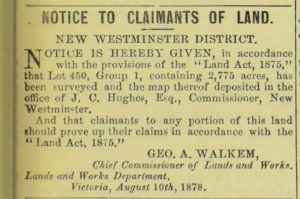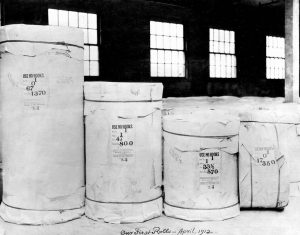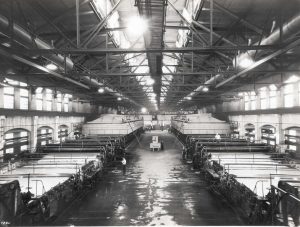
– with the Mill as backdrop
Ask any long-time Powell River resident and you’ll soon hear that “it was the Mill that built this Town“. I have no doubt of that, as it forms the backdrop for, well, pretty much everything.
And its been there…
…for a long time…
But who owned it? And the lands surrounding it?
History

– Rod LeMay (Powell River Historical Museum and Archives)
It’s an interesting story, and several books have been written on the subject. I will offer only a brief overview here.
Useful summaries can be found at Memory BC, the Townsite Heritage Society and the internet Wayback Machine.
You can also find wonderful and nicely-captioned period photographs at the Powell River Historical Museum and Archives and the open collections of the University of British Columbia.
The land purchase
According to one account, a timber lease surrounding the original Tla’amin settlement of Tees’kwat was “illegally purchased” by one R.P. Rithet in 1873. The lease is described as being 15,000 acres in size – which is about 3 times the land area of the modern Municipality of Powell River.
While the legality of the sale is perhaps arguable, this description of the size of it, and the timing of it, is incorrect.

The extent of lands purchased by the Robert Paterson Rithet (that is, Lot 450) was 2,775 acres. The land title is dated 24 October 1878.
The Crown retained specific rights, including those for “making roads, canals, bridges, towing-paths, or other works of public utility or convenience”, “raising gold or silver ore”, “rights of carrying water”, and obtaining “gravel, sand, stone, lime, timber, or other material which may required in the construction, maintenance, or repair of any roads, ferries, bridges or other public works.”
Notably, timber rights were not retained. by the Crown – the purchase price included the trees. All for the princely sum of a dollar an acre.
The Mill

– Catalyst Paper (Powell River Historical Museum and Archives)
The Minnesota-based company of Brooks and Scanlan formed the Powell River Paper Company in 1909, becoming simply the Powell River Company in 1911. Impressive engineering feats quickly followed.
The Powell River dam was constructed, the planned “garden city” of Townsite was constructed, and the new mill produced its very first rolls of newsprint in April of 1912.
By the early 1920s the mill had become the largest paper mill in North America, by the 1960s it had become become one of the world’s largest. The mill has changed ownership several times.

Powell River Historical Museum and Archives
The original company merged with MacMillan Bloedel Ltd to become MacMillan Bloedel & Powell River Ltd in December of 1959.
The “Powell River” label was later abandoned and it became simply MacMillan Bloedel Ltd in 1966 – a name which was to last for decades and leave an indelible stamp upon British Columbia.
Alas, in the end all things end, and “MacBlo” was no exception.
Restructuring
A major corporate restructuring led to MacMillan Bloedel Ltd separating its milling and timber operations in 1998.
The Mill thereafter operated briefly as 558654 British Columbia Ltd and Pacifica Poplars Ltd before being acquired by Norske Skog Canada in 2001. More name changes ensued, becoming Norske Canada in 2002 and Catalyst Papers in 2005. Catalyst was sold to Paper Excellence in 2019.
From my perspective, what is clear from all this is that from the time of its incorporation in 1955, the Municipality of Powell River was very much a “company town.” This was visibly reflected in its land tenure and in policies such as “Section 21”.
